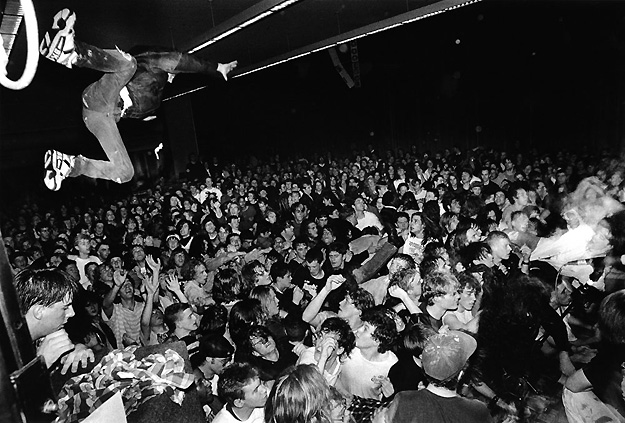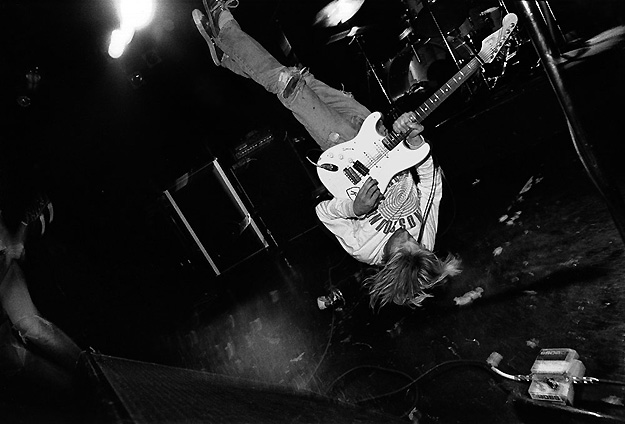This post has not been edited by the GamesBeat staff. Opinions by GamesBeat community writers do not necessarily reflect those of the staff.
Editor's note: Rob uses Kurt Cobain's appearance in Guitar Hero 5 to examine his dislike of the Guitar Hero series as a whole. This isn't your normal "Guitar Hero sucks" rant; it's a well-written look at how video games and rock and roll can-or-can't work together. I wonder what Kurt would have to say about all of this. "You Know You're Right" perhaps? – Aaron
 There’s been one nagging topic on my mind for the last several days, infesting my cerebral cortex like a colony of ants.
There’s been one nagging topic on my mind for the last several days, infesting my cerebral cortex like a colony of ants.
As I write this, I’m listening to, appropriately enough, Nirvana’s In Utero. One of my favorite songs on the album, “Milk It,” is playing. I’m drawn to this song by its subtly chaotic verse structure that cleverly hides a melody only to surprise the listener with the break-in of drummer Dave Grohl’s characteristic hard-hitting beats set to a sinisterly noisy hook hammered into the ears by Krist Novaselic’s thundering bass and Kurt Cobain’s sludgy guitar.
By now, you may have guessed the topic pestering my brain — the recent Guitar Hero 5 controversy surrounding the likeness of Kurt Cobain as a playable character. We’ve all seen the rather silly, and disturbing, gameplay videos of Cobain rapping Flavor Flav rhymes and singing Bon Jovi love songs.
But I’m not so much outraged by Cobain’s inclusion in the game, the likes of which was probably inevitable given the circumstances of his legacy. Nor am I outraged by his likeness being a playable character, either; I’m mostly just disturbed by the performance.
What’s been on my mind isn’t outrage but revelation — this episode in corporate buffoonery has helped me to understand why I’ll never enjoy games like Guitar Hero or Rock Band (outside of being piss drunk with friends and queuing up, surprisingly, Nirvana’s “Territorial Pissings” with the opportunity to play the drums.)
My reasons aren’t even remotely similar to recent rock stars, former Rolling Stones bassist Bill Wyman and Pink Floyd Drummer Nick Mason, who have voiced hypocritical opposition to guitar-based rhythm games, though I am sympathetic to their concerns.
Nor is it my inability to wrap my head about the concept of pressing the fret buttons before I hit the strum bar. Years of guitar playing has burned in my mind and my muscle reflexes to press my fingers down at the same moment I strum the strings.
 A song like “Territorial Pissings” is the anti-guitar hero song, representing the anathema of the guitar hero in the traditional arena rock sense of the term. It’s brash, abrasive, fast, short, and utterly lacking in any sort of virtuosity.
A song like “Territorial Pissings” is the anti-guitar hero song, representing the anathema of the guitar hero in the traditional arena rock sense of the term. It’s brash, abrasive, fast, short, and utterly lacking in any sort of virtuosity.
And this is exactly why I dislike Guitar Hero-type games. Nirvana’s inclusion in Guitar Hero 5 finally brought to the forefront this truth.
Nirvana was a band steeped within the growing misfit music subculture of Seattle in the late '80s. Later termed Grunge, the bands of this scene were of a different beast than their contemporaries or even their influences.
The sound was a crossover between metal and punk — the style emphasized metal’s low-end, heavy, and slow aesthetic and coupled that with the punk ethos of DIY attitudes and collectiveness, while only ever recognizing a guitar players’ ability to devise unique playing styles and controlled dissonance.
In contrast, the more glam influenced metal of the day, like Guns ‘n’ Roses, was the complete opposite. Where punk was about removing the barrier between performer and audience, metal was instead about celebrating this barrier. The metal of this era was a throwback to the arena rock of the early '70s and the new virtuosity, where bands like Van Halen had popularized technical skill that was stratospheres above anything that had come before.
Games like Guitar Hero are in the same spirit as metal, and in many ways, they have to be in order to be a challenging game in the traditional sense. Intrinsically, Guitar Hero celebrates the virtuosity of metal by turning it into a rhythm game. Being good a playing Guitar Hero can be viewed in a similar way as being a technically proficient guitar player.
 Cobain made no contentions about his sympathies towards the punk critique of virtuosity, either. In 1991: The Year Punk Broke, a documentary of Sonic Youth’s ’91 European tour, Cobain was quoted as saying, “Punk rock should mean freedom — liking and accepting anything that you like, playing whatever you want, as sloppy as you want, as long as it’s good and it has passion.”
Cobain made no contentions about his sympathies towards the punk critique of virtuosity, either. In 1991: The Year Punk Broke, a documentary of Sonic Youth’s ’91 European tour, Cobain was quoted as saying, “Punk rock should mean freedom — liking and accepting anything that you like, playing whatever you want, as sloppy as you want, as long as it’s good and it has passion.”
In his journal, Cobain wrote, “Someone told me that there are… Guitar Institutes of Technology… where they teach you how to be a lame un-original jukebox hero… Uh, gee I guess what I’m trying to say is: theory is a waste of time.”
Cobain’s antagonism towards this style of playing and its worship is best represented in the band’s refusal to be the opening act on the Guns ‘n’ Roses’/Metallica Stadium tour, which was an extension of a deep loathing Cobain had for singer Axl Rose.
Cobain’s characterization of one of metal’s most hallowed institutions, the guitar hero, as a “lame un-original jukebox hero” is apt when applied to games like Guitar Hero. These rhythm games invoke the same sort of focus on technical skill that metal’s real life guitar heroes cultivated in fans.
Having been a part of punk subcultures for more than a decade-and-a-half of my life in some form, whether collecting records, attending shows, or playing in bands, I too am philosophically opposed to the ideas presented in these kinds of rhythm games. I am turned off by the focus on virtuosity and the performer.
Is there hope for a new direction in guitar-based rhythm games? Maybe. Harmonix’s Rock Band Network could be what the Sex Pistols were to Rush when the group hit the streets in late ‘75. The door is opening to allow any performer to record and upload songs to Rock Band, which has the potential to develop its own sort of rebellion against the arena rock focus of current guitar-based rhythm games.
Or maybe not.
[video:http://www.youtube.com/watch?v=ucOHDkSunXM 425×344]
Reference: This Ain't the Summer of Love: Conflict and Crossover in Heavy Metal and Punk. All photography by Charles Peterson.
